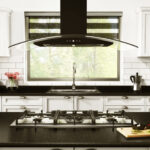Cooking releases a lot of smoke, oil fumes, moisture and aromas. These substances settle on electronic appliances, cabinets, walls and ceilings, coating them in a thin film of grease. This not only makes the kitchen look grimy, but also affects human health.
A Kitchen Chimney or an Exhaust Fan –What will be your choice?
Studies have shown that cooking smoke increases indoor air pollution and causes respiratory problems. Hence, it is very important that our kitchens have good air circulation. The stale air needs to be constantly replaced with fresh air from the outside so as to keep the pervasive smell of cooking from lingering around the house all the time.
The best way to ventilate your kitchen and home is through chimneys and exhaust fans. They are excellent at reducing indoor smoke. However, their modes of operation are a little different, as are their design and cost. Let us analyze the workings, advantages and disadvantages of each, and try and get a sense of which is better – kitchen chimney or exhaust fan.
We recommend you to check following –
Kitchen chimney
A kitchen chimney expels vapors and odors from the cooking area. It can be ducted or ductless. Ducted chimneys remove polluted air fully while ductless chimneys recycle the polluted indoor air and release it back into the house once the impurities are removed.

A ducted chimney consists of a hood/canopy, a filtration panel, a motor, exhaust pipes and a vent. A ductless chimney has a carbon layer in addition to all of these parts for fighting bad odors.
The modus operandi of a kitchen chimney is something like this: the canopy catches the smoke and routes it through the filtration panel which retains the oil and grease molecules, and allows the smoke and odors to pass through the exhaust ducts and go out through the vent. A motor or fan may also be used for drawing out the air and propelling it though the pipes.
Exhaust fan
A kitchen exhaust fan vents out impure air. It pushes out smoke, moisture, odors and soot from rooms, and allows fresh air from elsewhere to enter the space. In other words, an exhaust fan replaces stale air with fresh air by constantly circulating the room’s air.

The capacity of an exhaust fan is measured in cubic feet per minute (CFM) or cubic meter per hour (CMH). It denotes the volume of air the fan can replace in a minute or hour. The rate of ventilation also varies from room to room. It specifies the number of times per hour the entire volume of air in the room needs changing.
Exhaust Fan Vs Kitchen Chimney

Although chimneys and exhaust fans are both adept at combating indoor air pollution, a chimney is more effective as it can also eliminate oil and grease. The chimney filters attract oil droplets and take them out of the air current, thus preventing them from mixing with or escaping back into the house air.
Exhaust fans lack this ability. They can only remove smoke, carbon and odors. A chimney helps keep your kitchen clean and free of grime. Your appliances stay spotless and your walls and ceilings soot-free.
However, chimneys are expensive. They are not as pocket-friendly as exhaust fans. Chimneys require you to make permanent changes to the walls and cabinets of your cooking area whereas an exhaust fan just needs a hole in the wall and passage to channel out air.
Chimneys require extensive planning. The masonry, plumbing and interiors of the kitchen depend on where you plan to install the chimney. An exhaust fan is more flexible. Chimneys also require a lot of space. They are not as compact and lightweight as exhaust fans. However, cleaning a chimney might be a little easier than cleaning an exhaust fan.
These are some of the benefits and drawbacks of chimneys and exhaust fans. We hope we have been able to answer your queries, and shed light on some of the key aspects of kitchen ventilation.
Tips : Think of putting bamboo charcoal bags in your kitchen for continuous but natural way of reducing smoke and pollutants. The best possible option for reducing indoor air pollution is to choose a optimum air purifier for your home.
Buy a good vacum cleaner for your home to manage the dust and aerosols in the floor and other furniture of the house.

